Complementary to Sunday football, my older brother had an affinity towards the time-defying Price is Right, which we would watch in those boring summer mornings between school years or before the start of summer camp. Everything from Bob Barker’s skinny microphone, to the glittery on-air graphics and equally shiny Rod Roddy (RIP), to the, let’s say, effusive reactions of participants was inhumanly over the top, oddly exhilarating and irresistibly contagious. Having us back for more every morning.

Logo, Bob Barker with skinny mic and glitz! [Click for image for bigger view, pop-up]
Over the past five decades, game shows have relentlessly pushed the edge of reality by placing contestants and viewers in a time-(1), space-(2) and context-warp(3) where they are subject to emotional, physical and/or quizzical stress. And we love it. And by “we” I mean hundreds of millions of people across the globe and age range — Who Wants to be a Millionaire, alone drew 30 million viewers per show when it first aired on, then ratings-deprived, ABC. Game shows are big and important business for networks, they can turn previously lackluster schedule slots into overnight Must Watch TV, like NBC’s Monday night Deal or No Deal. And most game shows are designed to impress — and match their bankability.

The models, a briefcase with legs and a super-sized Matt Lauer. [Click for image for bigger view, pop-up]
Deal, for example, is a complicated extravaganza of models, a mysterious “banker”, a jumbotron and, of course, the soul-patched Howie Mandel — who I’m still waiting to drop on all fours and smell a contestant’s heinie — staged in a hi-tech Thunderdome-like set with built-in lighting effects more complicated than U2’s. Although it was probably Who Wants to be a Millionaire that set the stage, pun unavoidable, for futuristic pit-like environments where the crowd cheers participants on much like Romans did with gladiators but without all that thumb-up-thumb-down killing-the-other-guy part. Millionaire was not only an exercise in set overdesign, it also turned timely dramatic lighting changes into a wholesome gimmick that stressed the seriousness of Regis’ probing knowledge inquisition — always caringly making sure that the contestant’s was indeed his or her final answer. And it was perhaps Regis’ turn as enigmatic host that allowed Weakest Link to enjoy as much success as it did with every pronouncement of Brit-bred Anne Robinson’s “You are the weakest link—goodbye.” It also happened to mimic the set design with its space age sensibility and lighting orchestration. Where one show starts and the other ends is only delineated by the network it plays on, the host it chooses to be carried by and the potential of its syndication and global exportability.

Regis being Regis, crowd warm-up and a kids version of the show drastically bright. [Click for image for bigger view, pop-up]
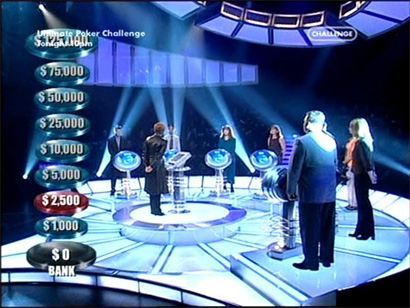
The Weakest Link.
These shows’ enforced and fabricated drama could likely be a reaction to well-groomed and polite game shows like Jeopardy, Wheel of Fortune and The $10,000 Pyramid, that, while still of the super-scale inclination, were brightly-lit, seemingly spacious and, well, calm. Pat Sajak and Alex Trebek are the epitome of cordiality, providing a hint of personality only when direly necessary but never bigger than life, or even bigger than the game. The shows themselves were also easier to understand: Double Jeopardy is nowhere near as baffling as anything that happens on Deal, and losing a turn or going bankrupt were as awful pitfalls as you could have on Wheel. While Wheel relied on the luck of the spin and Vanna White’s legs, Jeopardy has long been revered as one of the hardest shows on television where it is the contestants’ knowledge on a vast range of topics that is at the center of attention and consistently makes us question if, perhaps, we are irremediably dumb. No theatrics, no gimmicks, just good ol’ fashioned brainiacs on display. What is Jeopardy?

Somewhere between these two camps comfortably falls The World Series of Pop Culture. Created by Entertainment Weekly and VH1 based on the magazine’s popular “Pop Culture Quiz”, the show pits sixteen teams of three, through a three-round elimination bracket in a simple question and answer format. With the premise established, the show could be taken into a myriad of different directions, and with VH1 shows like The Surreal Life, World Series could have easily slid down that sad-campy path or it could have alternately been spun off from the “lively” cast of VH1’s Best Week Ever, where any of the talking heads could have been handed the hosting gig and we would have been subjected to a healthy dose of bleeping from their attitudinal swearing. Fortunately, Producer Michael Davies (whose previous credits include Millionaire) made a lot of smart, restraint choices and created a highly enjoyable show. (Apparently, the show was plagued with a small budget which might explain the normalcy of the show).

Hosts Pat Kiernan and Lisa Guerrero. © Donald Bowers, Getty Images
Hosting duties were handed to baby-faced Pat Kiernan, morning anchor of NY1 News who has been charmingly effective as the show’s question bearer. Each question is perfectly and (appropriately) dryly enunciated, even when faced with asking the name of the radio show, in a Saturday Night Live skit, in which Alec Baldwin, playing Pete Schweddy, is promoting his Schweddy Balls. The crowd cheers as Pat smirks when asked to repeat the question. Pat has enough charisma and appeal to carry the show by himself, but he also knows that it’s the motley crew of contestants that are the main attraction.
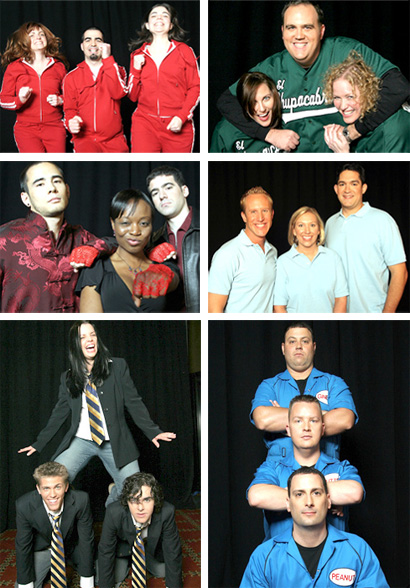
Left to right, top to bottom: We’re What Willis Was Talking About, El Chupacabra, Velvet Rope Revolution, The Boeghy Bunch, Highly Effective People and Peanut Butter & Ginelli. All images © Donald Bowers, Getty Images. [Click for image for bigger view, pop-up]
Selected from a national audition that included a written test and regional mock-tourneys, the 48 participants in the show all seem to enjoy the spotlight and have been criticized on some blogs for having been selected merely because they make good TV material. It is TV after all and everyone plays accordingly to their team’s name and uniform. The Velvet Rope Revolution are cocky and trendy in their nightlife wardrobe and signature runny panty-like red gloves, The Boeghy Bunch are annoyingly waspy in their polo shirts, Highly Effective People try to hide their inexperience in bad jackets and ties, Peanut Butter & Ginelli bring a little Sopranos to the show and El Chupacabra dress in baseball jerseys further diminishing and Americanizing the meaning of Chupacabra as nothing more than a funny-sounding word, but I digress. The participants are entertaining to watch as they work the crowd and interact with Pat and, much to the chagrin of those sitting at home, as they answer question after question proving that if there is something they know, it’s pop culture.
Part of the show’s appeal also lies in the fact that its viewership has seen the movies, heard the songs, read the books and followed the tabloids referenced in the questions. Unlike Jeopardy, this is stuff we all know (or think we know) and believe we could answer ourselves and it creates an instant connection with the flow of the show, Pat’s amicable presence and to the everydayness of the contestants who are simply exercising their cumulative years of otherwise unsocial behavior (i.e., marathon viewings of any given trilogy or the complete first season of, say, Lost). And the set design, I think, plays a large role in extending this connection.
World Series does not take place in a custom-made Hollywood set, it is performed in New York’s Zigfield Theater, built in 1963, adding a slight touch of nostalgia (and imposed reality) that few contemporary shows strive for. With not much room to maneuver, the set is placed in the front of the dimly lit, velvet drape-flanked theater, with the crowd crowding right up to the front of the stage which looks like a cross between a giant photography studio “seamless” and a high-end, mahogany-clad skateboarding Quarter Pipe with three Arne Jacobsen Seven chairs and an ornate-bordered picture frame with a TV screen that displays the team logo on each side and two microphones front center. Nothing more, nothing less. For every round of questions, one member of each team steps up, walks to the microphone, adjusts it to the appropriate height (usually with comedic effect), the lights dim (perhaps in Davies’ need for at least one dramatic effect) and Pat, sitting in an unassuming booth in the middle of the crowd with just enough light to read, fires the questions. For some, the answers are easy, for others solely the property of the truly pop-illuminated.
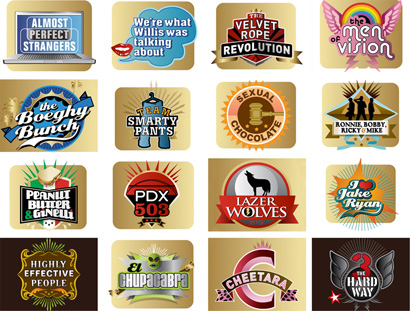
All 16 team logos. [Click for image for bigger view, pop-up]
The show isn’t perfect, but nothing on TV ever is — Seinfeld, maybe. Dramatic pauses between “That is correct” and “That is incorrect” can feel eternal, some of the contestants are unbearably annoying (specifically the Rachel Dratch wannabe from Cheetara), the aftermath interviews by buxom Lisa Guerrero don’t pop, and — it wouldn’t be me if I let this pass — the team logos, in all their Illustrator-gradient-glory, are riddled with that VH1 ambiguity that I don’t seem to be born to appreciate — but are indeed perfectly acceptable for TV fodder. Nonetheless World Series of Pop Culture is a brave example of Television that chooses restraint, delicacy and content over indulgence, exaggeration and the gratifying return on investment of highly produced spectacle.

World Series of Pop Culture airs next this Thursday at 10pm Eastern time on VH1.
Notes
1) We may watch a 30-minute episode that was filmed in 3 hours, or we may watch a 13-episode season spanning four or six months that was filmed in a week.
2) None of the sets or locations in these shows look like your couch, or your office or your backyard, unless you live in a giant tic-tac-toe and bunk with Whoopi.
3) The situations participants are placed in are rarely what you would call day-to-day activities.






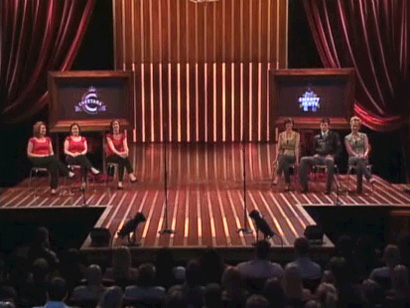
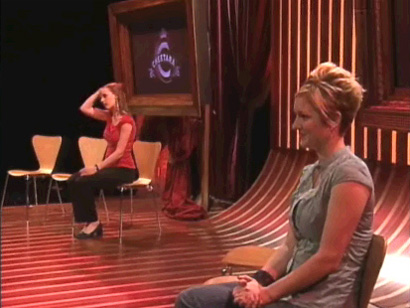
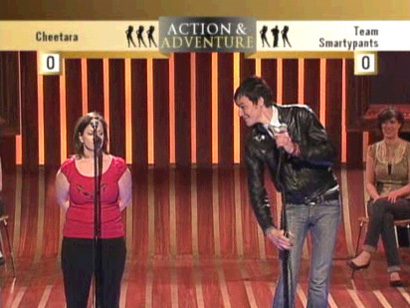
Chupacabra? If you’re going to talk about game shows with legendary Latin American creatures that suck, how about Don Francisco and “Sabado Gigante”?
And what Whoopi and I do in the privacy of a giant tic-tac-toe is none of your business. Unless you’ve taken Peter Marshall’s job. (As Madame/Wayland Flowers said, “Peter Marshall—that sounds like a security guard in a whorehouse.”)
On Jul.25.2006 at 12:01 PM